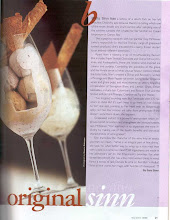Ancient History
Myths Much of what is written about the history of ice cream begins centuries ago...and it’s the stuff of legends. The claims of Nero (1st century A.D.) and the ancient Chinese (via Marco Polo) enjoying an “ice-cream-like dessert” are used to bolster ice cream’s long-standing popularity. Well, bunk. These desserts, while frozen, are not ice cream, as we know it, but more like sorbet or probably a sno-cone! Nero would have servants run to the mountains for fresh snow, and then race back (before it melted) to his palace where he would enjoy the frozen treats topped with fresh fruits. Again, it’s not the dairy treat we enjoy today, and further – it was something only royalty enjoyed (not everyone could have servants sent to the mountains, y’know).
The Dawn Of Ice Cream As We Know It Ice cream as a dairy delight was probably “discovered” in the 1600’s. The concept of flavored ices evolved, but no one is sure how. We do know that Charles I of England, or rather, his chef (either French or Italian), made ice cream a staple of the royal table. Depending on which version you read, either the chef had a secret recipe for ice cream and the king paid him a handsome reward to keep it a secret, or the chef was threatened with death if he divulged the recipe. Either way, once Chuck-One was beheaded in 1649, the chef blabbed. Soon nobility in Europe knew of, and enjoyed, “crème ice.”
Ice Cream Comes To The Colonies The still-for-the-rich “iced creams” were widely known in the 18th century on both sides of the Atlantic. Several recipes appear in a 1700 French cookbook, “L’Art de Faire des Glaces”, and here in the soon-to-be United States, ice cream was also known. Thomas Jefferson had a recipe for Vanilla ice cream, George Washington paid almost $200 (a chunk of money then) for a specific recipe, and James and Dolley Madison served ice cream at their second inaugural ball. Still, ice cream was limited in quantity and popularity, due to the enormous effort needed to make it (think two large bowls, lots of ice and salt, and 40 minutes of shaking one bowl while stirring the other – whew!).
If You Want Something Done Right, Ask A Woman Give credit to Nancy Johnson. In 1847 she developed the first hand-crank ice cream maker, and despite what you might read elsewhere, received a patent for it. Much of the confusion (and lack of credit) to Ms. Johnson comes from the fact that she sold her rights to William Young for just $200 (still a pretty good sum in those days). He at least had the courtesy to call the machine the “Johnson Patent Ice-Cream Freezer.”
Mass Production – Finally, Ice Cream To The People! The hand crank might have been fine for backyard picnics, but no one considered ice cream making as an industry – until Jacob Fussell in 1851. The milk dealer was looking for a way to keep a steady demand for his cream. He discovered that he could do so by turning it into ice cream – and he could get twice the price! His Baltimore factory utilized icehouses and a larger version of Johnson’s machine, and by the start of the Civil War he had additional ice cream plants in New York, Washington, and Boston. Ice cream still didn’t become a widespread phenomenon until the 20th century, when advances in refrigeration and power allowed for the dramatic increase in production as shown in the chart below:
Year | U. S. Production
(in gallons) |
1899 | 5 million |
1909 | 30 million |
1919 | 150 million |
However, before supply came demand…and the controversial “inventions” of the ice cream sundae and the ice cream cone.
The Birth Of The Sundae, Fact Or Fiction? There are several stories as to the birth of the ice cream sundae (as there are to its predecessor, the ice cream soda). Most of these “true accounts” revolve around concentrated efforts by Midwestern religious leaders in the late 19th century against “sucking soda” (I am not making this up). Evanston, Illinois was one such town, as was Two Rivers, Wisconsin. Both claim to have locals who circumvented the soda ban by serving ice cream topped with syrup, and they did it on Sunday, and then changed the name slightly to avoid any connection with the clergy…
Who REALLY Invented The Ice Cream Cone? And if you thought the invention of the sundae was confusing, you ain’t seen nothin’ yet. Many histories proclaim that the ice cream cone was invented in 1904 at the St. Louis World’s Fair (the Louisiana Purchase Exposition), when Syrian immigrant Ernest Hamwi gave some of his “zalabia” (a waffle-like pastry) from his pastry cart to neighboring Arnold Fornachou, who had run out of paper dishes to serve his ice cream in at his adjoining ice cream cart at the fair. Another version has Hamwi teaming up with a different ice cream vendor named Charles Menches, who also ran out of dishes.
Well, wait…yet another vendor named Abe Doumar said he created the cone and sold it nightly at the fair. Hang on…fair vendor David Avayou said the same thing, claiming he knew of “cones of pastry” from France. All in all there were about 50 ice cream vendors and more than a dozen waffle stands at the fair, so it’s very likely there were several vendors selling some version of an ice cream cone. Certainly, the cone became universally popular after this date. Despite the number of claimants, most ice cream experts and associations give the credit to Hamwi (see why below).
But - let us seriously consider Italo Marciony (also spelled Marchioni and Marcioni)– who claimed he created the ice cream cone on September 22, 1896! He sold his cones from a pushcart in New York City, and his claim may be the best, since he had a patent for a waffle mold, granted in December 1903, eight months before the St. Louis Fair! His invention was “…like a waffle iron and producing several small pastry cups with sloping sides.” I have a copy of it courtesy of Anthony Gullo of Hoboken, NJ, who also provided me with more about this fascinating, and little known inventor...
From Pushcart to Inventor - Italo Marciony Italo Marciony emigrated to the United States in the late 1800s, and although he lived in Hoboken, NJ for a time his fame resides solely in New York City. He began his business selling his homemade lemon ice from a single pushcart on Wall Street, but his business quickly grew into many carts.
Although he was successful he still had a small problem that was causing him to lose money. At the time, most ice cream from vendors was sold in serving glasses called "penny licks" (because you'd lick the ice cream from the glass, and it cost a penny to do so). There was a major problem with sanitation (or the lack thereof), but Marconi’s problem was that many people would accidentally break the glasses, or not so accidentally walk off with them. His first solution was to make cone-like containers out of paper, which worked fine until he was hit with a stroke of genius. He came up with the idea of making an edible container for his cool treat. So in 1896 he began baking edible waffle cups with sloping sides and a flat bottom - shaped like his serving glass - and it was an instant hit. On September 22, 1903, he filed a patent application out of the city and state of New York, and U.S. Patent No. 746971 was issued to him on December 15, 1903. So although he lived in Hoboken for a time, while selling his wares in the big city, and although my home town web sites claims him as our own, his patent clearly states that he is "Italo Marciony of New York."
So Who Really "Invented" The Ice Cream Cone? As I mentioned earlier, most give Hamwi the credit. This is because: -he had been a sailor, and early ice cream cones were supposedly shaped around a sailor's tool, which Hamwi had with him in his pastry cart (so the story goes), and -he eventually went on to start his own cone making company. Many people today think Henry Ford invented the automobile, and Bill Gates invented the computer. Not so, but each made these machines more like what we know them today. This is the category that I feel Hamwi fits into, as he took what already existed and made it into the cone shape we know today.
But I side with those who give the credit to Marciony, because his patented design was FIRST, and it resembled the "packaging" of ice cream as it was known then (the penny lick glass). Hamwi improved upon this design, but the concept of ice cream in an edible container belongs to Marciony. Hence, in my view (and a few others), he is the father of the American Ice Cream Cone.
To be sure, the St. Louis World's Fair popularized the cone, but it's invention came before this. In fact, you'll note that we refer to Marciony as the father of the American Ice Cream Cone. This is because there are other claimants who say they had the idea before this - there are English claims that go back to the 1890's, and one French claim of paper cones more than 100 years before this! Will we ever know who was first? Probably not...and wait, there's one more detail of local interest...
Seaside’s Historical Footnote To The Cone Controversy? I used to joke that, indirectly, Lewis and Clark were responsible for the ice cream cone, since they explored the Louisiana Purchase, and since the ice cream cone was made popular at the Louisiana Purchase Exposition in St. Louis a hundred years later. Now, another century since then, a picture caption from a historical record may bring it full circle.
In “A Pictorial History of Seaside & Gearhart” there is a picture of a small business with the caption, “First ice cream cone shop in Seaside near the turn of the century” (emphasis mine). Now, given what we know about the birth of the cone, one of three things is possible:
-By “turn of the century” the caption refers to several years (at least four or five) after the turn of the century, or
-The caption is incorrect and should read “…an ice cream shop…” (no cone), or
-Seaside was enjoying ice cream cones before the folks in St. Louis had their fair.
Obviously further research is needed. If anyone has any additional information on Seaside’s early ice cream businesses, and can clarify this or other early ice cream history, this ice cream lover would enjoy hearing it. Still, it’s clear that Seaside visitors had, and still have, a love affair with scoops of chocolate, strawberry, and vanilla…
And History Is Still Being Made Today...
In April, 2004, Zinger's Ice Cream began making homemade ice cream. Partly to celebrate the 100th anniversary of the ice cream cone (or 101st, if you are in the Marciony camp), and partly to offer visitors a better ice cream with more diverse flavors, "Zinger's Homemade" is a combination of old-fashioned creaminess and 21st Century flavors.
Be like Lewis and Clark - make the journey to Seaside to experience a little history of your own!


























